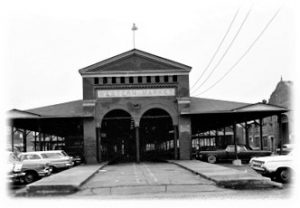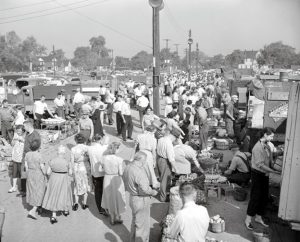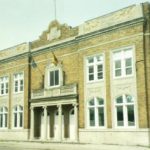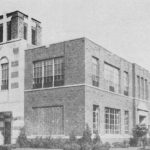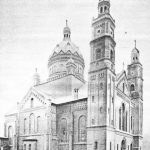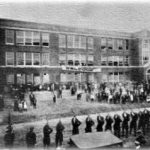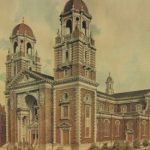A HISTORY OF THE WESTERN MARKET
MICHIGAN AVENUE AND 18TH STREET, DETROIT 48210
The Western Market, a wholesale food distribution hub, was located on Michigan Avenue and 18th Street in Detroit, across from the big Hygrade factory. It existed for over 70 years, from approximately 1891 until about 1965. It was west side Detroit’s counterpart to the Eastern Market, which was founded in 1891 in Detroit’s Cadillac Square for hay and wood sales. The Eastern Market relocated that same year to its current location at 2934 Russell Street, approximately a mile northeast of the downtown area, when sheds were installed and it became a central site for farmers to sell their goods.
The Western Market was not as large as the Eastern Market, but like the Eastern Market, it was a lively place. It was especially so on Saturday mornings, when the open-air market became packed with busy shoppers. The farmers who sold their goods at the market rented the sheds or stalls where their merchandise was sold. They also pulled their trucks in and sold their goods from the trucks’ beds. In the early years of the market, there was no Interstate highway system, and traveling to the Western Market was a long journey for the farmers. But the extensive trip was worth it, both for the farmers and their customers.
The farmers’ family members helped them at their market stands, and as shoppers passed by their sheds, the farmers could be heard barking out advertisements and prices for their products. Shoppers brought their own sturdy, oil cloth shopping bags from home in which to carry their wares back home with them.
People in the nearby neighborhood walked to the market. Some traveled there on streetcars. Beginning in 1863, the streetcars traveled from the downtown district to the Wyoming-Michigan Avenue area and back. The streetcars continued their routes in Detroit until 1956, when they were replaced by buses. In the 1930 – 1940 era, it cost six cents to ride the streetcar, with a transfer costing one cent. Students carrying books rode for five cents. The Western Market was one of the stops along the streetcar route.
Passengers got onto the streetcars after shopping at the Western Market with their oil cloth bags hanging from their arms, filled with fresh fruits and vegetables. Their bags often would contain live chickens—whose heads could be seen poking out from the tops of the bags. Some passengers even brought live Christmas trees onto the streetcars.
During the Great Depression, farmers from as far away as Ypsilanti and Pinckney went to the Western Market to sell their farm products. Sometimes, after a long day at the market, farmers didn’t sell enough goods to buy the necessary fuel for their trucks to make it back home. The kindness of local businessmen, such as Onufry (“Fred”) Warholak, owner of Warholak Tire Service at 9411 McGraw, often was their saving grace on those occasions. When the farmers came into his service station and Fred saw that they were in need, he purchased some of their goods, even though he didn’t need them—just so that they could buy enough gasoline for their trucks to make it back home.
Grocers during those times had to be savvy merchants. They went to the Western Market and purchased their fresh fruits and vegetables from the farmers, as well as seafood such as Bismarck herring (pickled herring filets), which were for sale by the barrelful. On a regular basis, they purchased their fresh meat from local packing houses such as Hygrade’s, a slaughterhouse and meat cutting factory that employed many Polish women. John Sobieski was their source for pork. The neighborhood Jewish wholesalers were their source for specialty items such as cigarettes and candy.
An important component of the Western Market was the West Side Grocers Association, located on Wesson and Michigan Avenue, where area grocers also went to stock up on their supplies.
Today, there exists no evidence of the Western Market, any vestiges of its existence completely obliterated by the I-75/I-96 freeway interchange. With the birth of supermarkets, most small, independently owned grocery stores faded into the shadows of our history. Along with them, the “street corner” society that many of us once knew and enjoyed disappeared—and with it, the Western Market. The memorable experience of the colorful sights, sounds, and odors of the Western Market on a Saturday morning are now also a part of our history.
Sources:
- Bartus-Sidick, Mary. “The Six-Cent Trip.” In WSDPAHS e-Newsletter. Volume 66, April 2018, pp. 3 – 4.
- Bartus-Sidick, Mary. “The Western Market.” In WSDPAHS e-Newsletter. Volume 43, June 2014, p. 21.
- Gomulka Palazzolo, Laurie A. “From Poland with Love: A Tale of Two Immigrant Trunks.” In The Eaglet, the official journal of the Polish Genealogical Society of Michigan. October 2007.
- https://detroithistorical.org/learn/encyclopedia-of-detroit/eastern-market-historic-district
- https://www.hourdetroit.com/the-way-it-was-articles/detroits-western-market-1956/
- https://www.lonelyplanet.com/usa/great-lakes/detroit/attractions/eastern-market/a/poi-sig/1131582/361937
- Pikulinski, Jerome. “West Side Detroit Grocery Stores: Memories of Street Corner Societies.” In WSDPAHS e-Newsletter. Volume 27, October 2011, pp. 6 – 7.
Photos:
- Western Market Main Building Exterior, ca. 1960s
Source: https://www.pinterest.com/pin/places-to-visit–309692911862968805/ - Crowds at Detroit’s Western Market, 1956
Source: https://www.hourdetroit.com/the-way-it-was-articles/detroits-western-market-1956/
